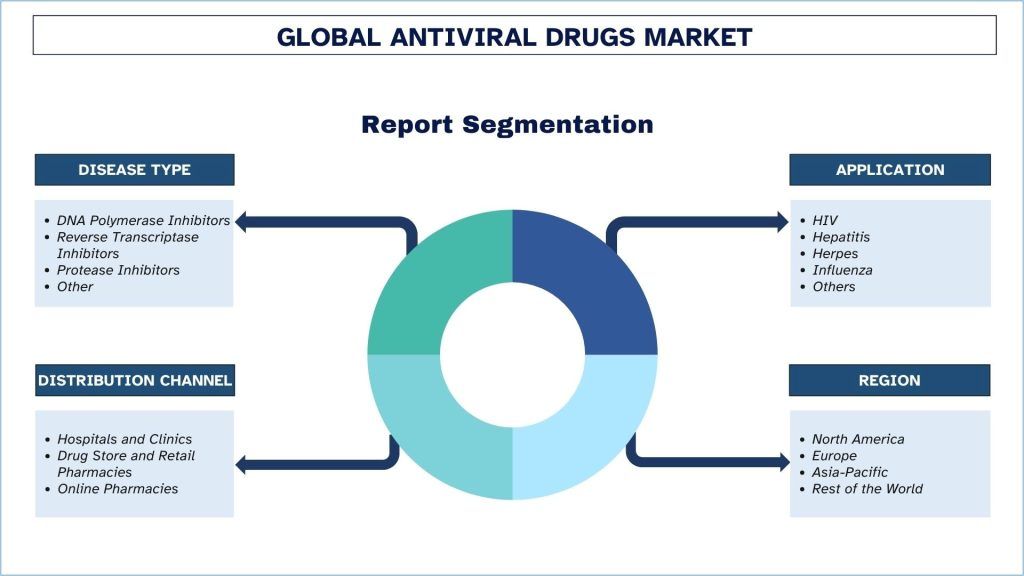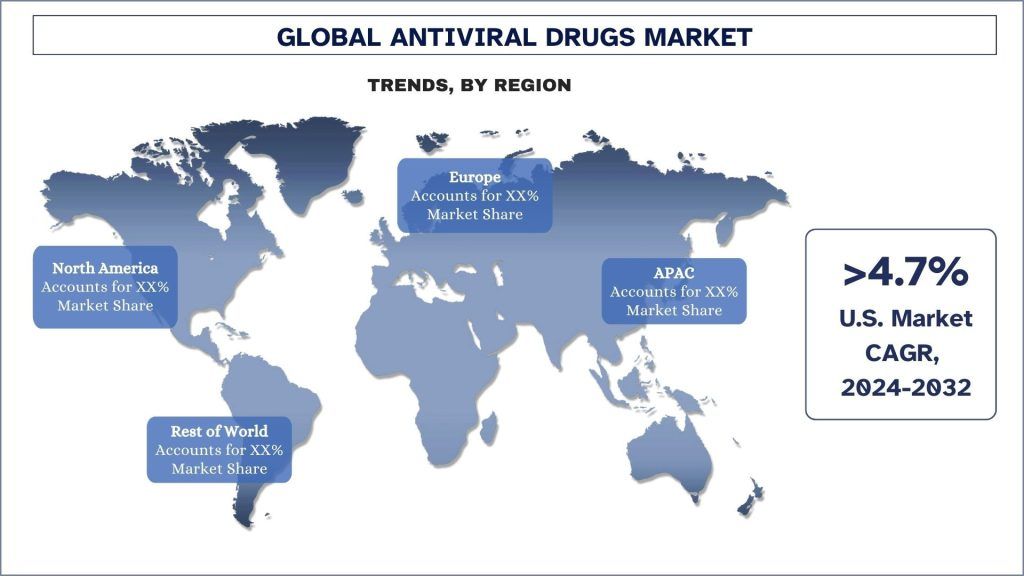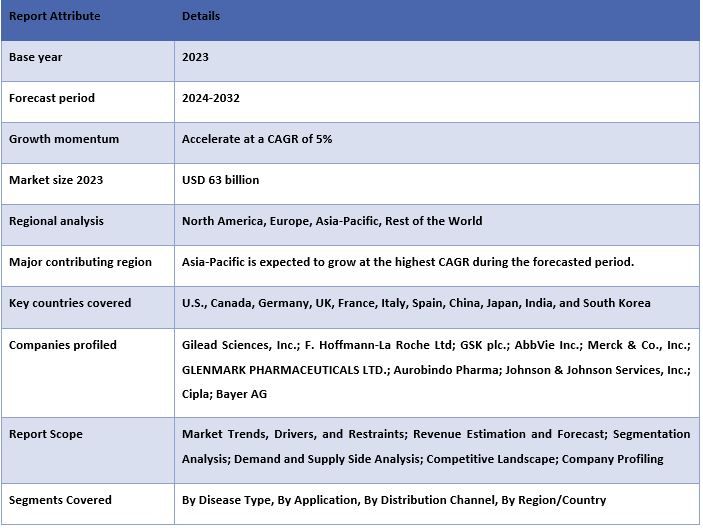- Home
- About Us
- Industry
- Services
- Reading
- Contact Us
Antiviral Drugs Market: Current Analysis and Forecast (2024-2032)
Emphasis on Drug Class (DNA Polymerase Inhibitors, Reverse Transcriptase Inhibitors, Protease Inhibitors, and others); Application (HIV, herpes, hepatitis, influenza and others); Distribution channel (hospitals and clinics, drug stores & retail pharmacies, and online pharmacies); Region/Country (North America (US, Canada, Rest of North America); Europe (Germany, UK, France, Italy, Spain, Rest of Europe); Asia-Pacific (China, India, Japan, South Korea, Rest of Asia-Pacific); and Rest of World)
Antiviral Drugs Market Size & Forecast
The Antiviral Drugs market was valued at approximately USD 63 billion in 2023 and is expected to grow at a substantial CAGR of around 5% during the forecast period (2024-2032) owing to the increasing prevalence of viral infections such as HIV, hepatitis, influenza, and COVID-19 drives demand for antiviral drugs.
Antiviral Drugs Market Analysis
Antiviral is categorized as a therapeutic agent that is employed in the prevention as well as treatment of virus infections to slow down the growth and reproduction cycles of viruses in the host organism. Antibiotics differ from antiviral drugs in the sense that antibiotics are used to kill bacteria while antiviral drugs work by interfering with viral functioning to slow the progress of the disease, lessen its impact, or treat symptoms. The drugs can be used for the treatment of viral infections including HIV, hepatitis B and C, influenza, and COVID-19 as well as other viral infections.
Moreover, ongoing research and technological advancements lead to the development of more effective and safer antiviral drugs, enhancing treatment options. In May 2023, the U.S. Food and Drug Administration approved the oral antiviral Paxlovid (nirmatrelvir tablets and ritonavir tablets, co-packaged for oral use) for the treatment of mild-to-moderate COVID-19 in adults who are at high risk for progression to severe COVID-19, including hospitalization or death. Paxlovid is the fourth drug—and first oral antiviral pill—approved by the FDA to treat COVID-19 in adults. Therefore, continuous investment in R&D is crucial for developing new antiviral drugs and improving existing treatments. Companies that innovate and adapt to new viral threats will gain a competitive edge. In November 2021, Pfizer continued to invest up to approximately USD 1 billion to support the manufacturing and distribution of this investigational treatment, including exploring potential contract manufacturing options to help ensure access across low- and middle-income countries, pending regulatory authorization.
Antiviral Drugs Market Trends
This section discusses the key market trends influencing the various segments of the Antiviral Drugs market as identified by our research experts.
Reverse Transcriptase Inhibitors Segment Transforms Antiviral Drugs Industry
This is because reverse transcriptase inhibitors which are part of antiviral drugs owe most of their market base from treatment of HIV/AIDS. These include the nucleoside and the non-nucleoside reverse transcriptase inhibitors which as first-line therapy help instigate the replication of HIV by inhibiting the reverse transcriptase enzyme. It is crucial for the treatment of HIV infection, bettering patients’ condition, and increasing their life span, and thus is a crucial class of drugs. The increasing rates of HIV/AIDS around the world and lifelong treatment needs. Since RTI formulations are a very active research area, the constantly growing innovations with some of the formulations presenting lesser side effects than the previous ones, or even improved efficacy push market growth. Also, more awareness and availability of HIV treatment within the developing regions boost the market of RTIs.

North America leads the market.
North America held the largest share of the market due to the higher incidence of viral diseases including HIV, hepatitis, and influenza hence creating demand for drugs to cure the diseases. As per KFF.org in 2024, more than 1.2 million people living with HIV in the U.S. and there are an estimated 31,800 new infections (cases among people who are both diagnosed and undiagnosed) in 2022. There are healthy healthcare systems in the region as well as enhanced research institutions that ensure consistent drug development. Additionally, high government support and well-developed rules and regulations for drugs make them more accessible and secure. High healthcare ratio and large patient population are other factors, which also contribute to market growth. Further, there is a strong concentration of leading pharma players coupled with a competitive market environment, which ensures constant progress with antiviral treatment. Awareness and education of patients can also be a crucial factor for higher drug adoption rates.

Antiviral Drugs Industry Overview
The Antiviral Drugs market is competitive, with several global and international players. The key players are adopting different growth strategies to enhance their market presence, such as partnerships, agreements, collaborations, new product launches, geographical expansions, and mergers and acquisitions. Some of the major players operating in the market are Gilead Sciences, Inc.; F. Hoffmann-La Roche Ltd; and GSK plc.; AbbVie Inc.; Merck & Co., Inc.; GLENMARK PHARMACEUTICALS LTD.; Aurobindo Pharma; Johnson & Johnson Services, Inc.; Cipla; Bayer AG.
Antiviral Drugs Market News
- In November 2021, Pfizer Inc. announced it is seeking Emergency Use Authorization (EUA) of its investigational oral antiviral candidate, PAXLOVID (PF-07321332; ritonavir), for the treatment of mild to moderate COVID-19 in patients at increased risk of hospitalizations or death.
- In January 2022 – GlaxoSmithKline plc and Vir Biotechnology, Inc. announced that the US Government will purchase an additional 600,000 doses of sotrovimab, an investigational monoclonal antibody for the early treatment of COVID-19, enabling further nationwide access to sotrovimab for patients. The additional 600,000 doses will be delivered throughout the first quarter of 2022. This agreement is an amendment to earlier commitments announced with the US Government in November 2021.
Antiviral Drugs Market Report Coverage

Reasons to buy this report:
- The study includes market sizing and forecasting analysis validated by authenticated key industry experts.
- The report presents a quick review of overall industry performance at one glance.
- The report covers an in-depth analysis of prominent industry peers with a primary focus on key business financials, product portfolios, expansion strategies, and recent developments.
- Detailed examination of drivers, restraints, key trends, and opportunities prevailing in the industry.
- The study comprehensively covers the market across different segments.
- Deep dive regional level analysis of the industry.
Customization Options:
The global Antiviral Drugs market can be customized further as per the requirement or any other market segment. Besides this, UMI understands that you may have your own business needs, hence feel free to connect with us to get a report that completely suits your requirements.
Table of Content
Research Methodology for the Antiviral Drugs Market Analysis (2022-2032)
Analyzing the historical market, estimating the current market, and forecasting the future market of the global Antiviral Drugs market were the three major steps undertaken to create and analyze the adoption of Antiviral Drugs in major regions globally. Exhaustive secondary research was conducted to collect the historical market numbers and estimate the current market size. Secondly, to validate these insights, numerous findings and assumptions were taken into consideration. Moreover, exhaustive primary interviews were also conducted, with industry experts across the value chain of the global Antiviral Drugs market. Post assumption and validation of market numbers through primary interviews, we employed a top-down/bottom-up approach to forecasting the complete market size. Thereafter, market breakdown and data triangulation methods were adopted to estimate and analyze the market size of segments and sub-segments of the industry. Detailed methodology is explained below:
Analysis of Historical Market Size
Step 1: In-Depth Study of Secondary Sources:
A detailed secondary study was conducted to obtain the historical market size of the Antiviral Drugs market through company internal sources such as annual reports & financial statements, performance presentations, press releases, etc., and external sources including journals, news & articles, government publications, competitor publications, sector reports, third-party database, and other credible publications.
Step 2: Market Segmentation:
After obtaining the historical market size of the Antiviral Drugs market, we conducted a detailed secondary analysis to gather historical market insights and share for different segments & sub-segments for major regions. Major segments are included in the report as disease type, application, distribution channel, and regions. Further country-level analyses were conducted to evaluate the overall adoption of testing models in that region.
Step 3: Factor Analysis:
After acquiring the historical market size of different segments and sub-segments, we conducted a detailed factor analysis to estimate the current market size of the Antiviral Drugs market. Further, we conducted factor analysis using dependent and independent variables such as disease type, application, distribution channel, and regions of the Antiviral Drugs market. A thorough analysis was conducted for demand and supply-side scenarios considering top partnerships, mergers and acquisitions, business expansion, and product launches in the Antiviral Drugs market sector across the globe.
Current Market Size Estimate & Forecast
Current Market Sizing: Based on actionable insights from the above 3 steps, we arrived at the current market size, key players in the global Antiviral Drugs market, and market shares of the segments. All the required percentage shares split and market breakdowns were determined using the above-mentioned secondary approach and were verified through primary interviews.
Estimation & Forecasting: For market estimation and forecast, weights were assigned to different factors including drivers & trends, restraints, and opportunities available for the stakeholders. After analyzing these factors, relevant forecasting techniques i.e., the top-down/bottom-up approach were applied to arrive at the market forecast for 2032 for different segments and sub-segments across the major markets globally. The research methodology adopted to estimate the market size encompasses:
- The industry’s market size, in terms of revenue (USD) and the adoption rate of the Antiviral Drugs market across the major markets domestically
- All percentage shares, splits, and breakdowns of market segments and sub-segments
- Key players in the global Antiviral Drugs market in terms of products offered. Also, the growth strategies adopted by these players to compete in the fast-growing market
Market Size and Share Validation
Primary Research: In-depth interviews were conducted with the Key Opinion Leaders (KOLs) including Top Level Executives (CXO/VPs, Sales Head, Marketing Head, Operational Head, Regional Head, Country Head, etc.) across major regions. Primary research findings were then summarized, and statistical analysis was performed to prove the stated hypothesis. Inputs from primary research were consolidated with secondary findings, hence turning information into actionable insights.
Split of Primary Participants in Different Regions

Market Engineering
The data triangulation technique was employed to complete the overall market estimation and to arrive at precise statistical numbers for each segment and sub-segment of the global Antiviral Drugs market. Data was split into several segments and sub-segments after studying various parameters and trends in the disease type, application, distribution channel, and regions of the global Antiviral Drugs market.
The main objective of the Global Antiviral Drugs Market Study
The current & future market trends of the global Antiviral Drugs market were pinpointed in the study. Investors can gain strategic insights to base their discretion for investments on the qualitative and quantitative analysis performed in the study. Current and future market trends determined the overall attractiveness of the market at a regional level, providing a platform for the industrial participant to exploit the untapped market to benefit from a first-mover advantage. Other quantitative goals of the studies include:
- Analyze the current and forecast market size of the Antiviral Drugs market in terms of value (USD). Also, analyze the current and forecast market size of different segments and sub-segments.
- Segments in the study include areas of the disease type, application, distribution channel, and regions.
- Define and analyze the regulatory framework for the Antiviral Drugs
- Analyze the value chain involved with the presence of various intermediaries, along with analyzing customer and competitor behaviors of the industry.
- Analyze the current and forecast market size of the Antiviral Drugs market for the major region.
- Major countries of regions studied in the report include Asia Pacific, Europe, North America, and the Rest of the World
- Company profiles of the Antiviral Drugs market and the growth strategies adopted by the market players to sustain the fast-growing market.
- Deep dive regional level analysis of the industry
Frequently Asked Questions FAQs
Q1: What is the Antiviral Drugs market's current size and growth potential?
Q2: What are the driving factors for the growth of the Antiviral Drugs market?
Q3: Which segment has the largest share of the Antiviral Drugs market by product?
Q4: What are the major trends in the Antiviral Drugs market?
Q5: Which region will dominate the Antiviral Drugs market?
Related Reports
Customers who bought this item also bought











